|
 570 3rd Ave # 219 570 3rd Ave # 219
Bethel, AK 99559
(907) 543-1541
 625 C Street
Anchorage, AK 99501 625 C Street
Anchorage, AK 99501
(907)929-9200
anchoragemuseum.org
|
|
Nucugcuun Fire Drill Cord Handles
 |
|
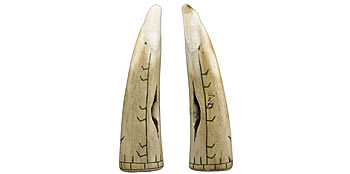
|
Fire Drill Cord Handles made from walrus teeth, used to rotate the drill stick during friction fire starting.
Frank Andrew said that walrus bones, especially walrus jawbones, were stronger and more durable than ivory, which tended to crack.
|
E. W. Nelson, 1880, Cape Vancouver, Department of Anthropology, Smithsonian Institution 36483 |
| |
Tugkar Carved Tusk

|
Carved Tusk from Nunivak.
Frank Andew noted: "They engraved carefully, and when the carved area got deep, they would spill water over it. Ivory is easier to work on when it is periodically dipped in water." |
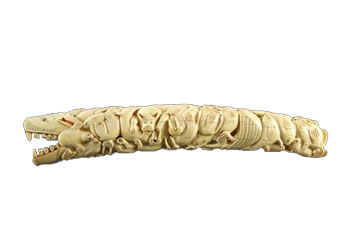 |
|
P. Manship, 1965, Peabody Essex Museum 41020 |
Science panel: Why ivory cracks
Ivory is a type of dentin, or calcified connective tissue, that normally includes some water. The water molecules create spaces between the weakly cross-linked protein molecules of the tissue. When the ivory dries out, the spaces where the water was shrink, the protein molecules get closer, and cracks form as the tissue contracts.

|
Inuguaq Ivory Doll
 |
|
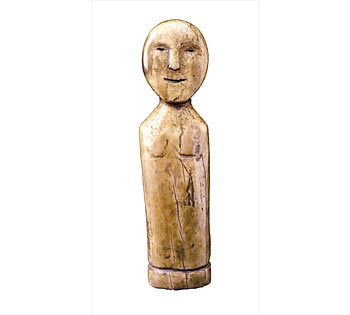
|
Ivory Doll from Rasboinsky.
|
E. W. Nelson, 1882, Department of Anthropology, Smithsonian Institution 48709 |
| |
Nagtuqaq Ivory Belt Fastener

|
Ivory Belt Fastener
Frank Andrew observed: "They made ivory into belt hooks and bag fasteners, story knives, dolls, earrings, labrets, and other things used for beautification." |
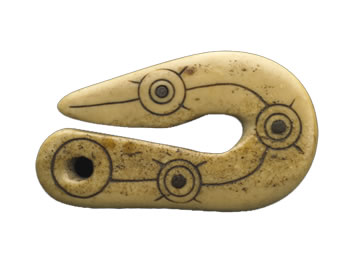 |
|
E. W. Nelson, 1879, Araiyakcaq, Department of Anthropology, Smithsonian Institution 37332 |
Iinruq Walrus Ivory Amulet
 |
|
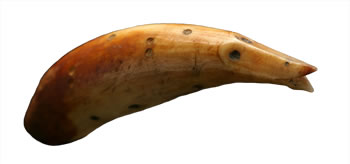
|
Iinruq/Walrus Ivory Amulet made to both protect and empower the owner.
|
B. Gierke, 1920, Bethel, Burke Museum of Natural History and Culture, Seattle 1.2E766 |
Naqugun Caribou Tooth Belt

|
 |
| |
J. A. Jacobsen, 1882, Ethnologisches Museum Berlin IVA5439 |
Caribou Tooth Belt with fox teeth and bullet casings dangling from the edge.
Theresa Moses recalled how women were careful with their bodies and always used belts to keep their personal debris, like dust, from spreading out to boys and men.
Paul John said: "The process of acquiring materials for these belts was not easy. When other people saw women wearing belts like these, they knew that their husbands were excellent hunters." |
Tugkarmek Piliaq Ivory Device
 |
|
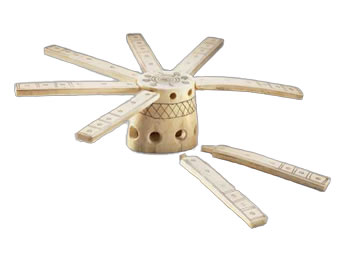
|
Ivory Device with incised circle designs, said to be for gambling but possibly a calendar with individual arms to be inserted every seventh day in holes carved around the base.
|
C. M. Garber, 1925, Courtesy, National Museum of the American Indian, Smithsonian Institution 22/7458 |
| |
Iqmiutaak Ivory Tobacco Box

|
Ivory Tobacco Box from Nelson Island with circle and dot designs, ellanguat, literally "model or pretend universe." |
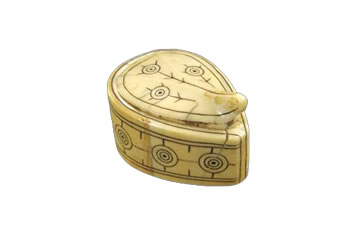 |
|
S. Wheatland, Peabody Essex Museum 39617 |
Qungasvik Ivory Box
 |
|
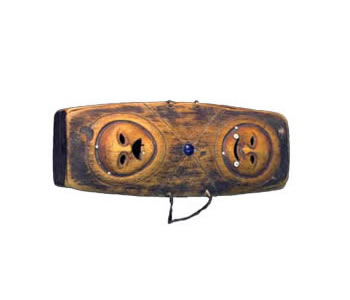
|
Ivory Box with bird foot design, from Nunivak Island.
|
G. B. Gordon, 1905, University of Pennsylvania Museum of Archaeology and Anthropology NA427 |
| |
As'utet Ivory Earring Hooks

|
Ivory Earring Hooks held in a wooden storage device, as the hooks on earring backs easily broke.
Wassilie Berlin noted: "Once the earring hook's front and sides were done, it was placed in this vice and decorated. Gosh, people back in those days were so resourceful." |
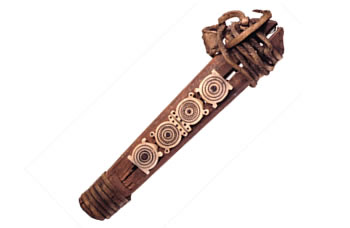 |
|
J. A. Jacobsen, 1882, Ethnologisches Museum Berlin IVA5091 |
Next
|
|

